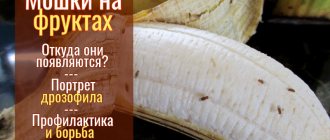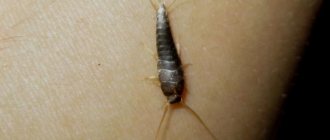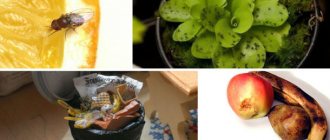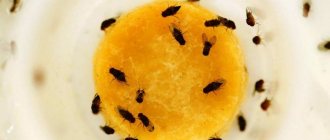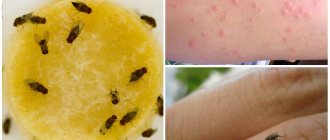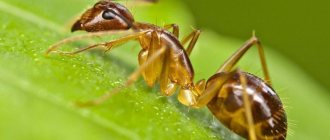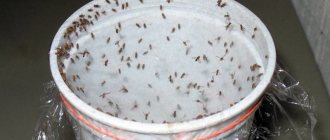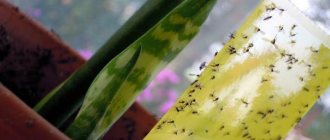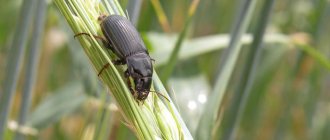They forgot to take out the trash on time or didn’t notice how an apple rolled behind the kitchen cabinet and began to rot there, and now small and annoying fruit flies appeared in the house. They multiply quickly, some bite, spoil food and damage vegetation in the apartment. In short, they don’t give me peace. The question arises, how to get rid of midges at home. Fortunately, there are many effective methods; you can fight insects yourself without involving exterminators.
Causes of midges
Midges don't just appear in the house.
- Insects are attracted to dirty vegetables and fruits. Larvae are always present on the fruits, and when the product rots, they become active, since such a fruit is easy to eat. The life of fruit flies is short, but reproduction in favorable conditions is off the charts.
- In the same way, midge larvae “wake up” in an apartment if there is garbage in the house. They will feed on rotting food scraps in the trash can. Larvae can also be found on the surface of the bucket, so it is worth cleaning it regularly.
- The condition of pet trays and feeders is also a source of midges in the apartment. Just like stagnant water in an aquarium.
- Midges live in indoor plants. They especially love flower pots whose soil has been fertilized with tea leaves. With high soil moisture, the appearance of insects is inevitable.
- If the housewife keeps the kitchen clean, but insects still haunt her, check the sewer system. There may be household waste that has begun to decompose and attract uninvited guests.
Therefore, food decomposition is a potential cause of midge infestation in your home. Once you get rid of the original source, you will say goodbye to annoying flies.
How long does a midge bite take to heal?
Each person who has been bitten by a midge has their own individual bite healing time. It is related to age and health status, general immunity, location of bites and their number.
On average, swelling disappears after 2–4 days, and redness, swelling and other symptoms disappear after 7–9 days. It is clear that we are talking about standard situations when the bite is not accompanied by any serious complications.
Bites
Drosophila species
The most common food types of insects are found. Habitat: food and waste. The color of this variety ranges from burgundy to black. Fortunately, getting rid of them is simple: do regular deep cleaning and remove power sources.
Clothing varieties also appear. They live in stale things. Getting rid of them is much more difficult. Preventive measures include the use of fragrances that repel insects (the most effective is the smell of lavender). They also use dried hazel leaves.
In places with high humidity - in the kitchen, in the bathhouse, in the bathroom - water midges appear. Regular ventilation of the premises will help get rid of it.
How to distinguish fruit flies from other midges?
People often do not know how to distinguish fruit midges from sewer midges, biting forest midges, “fungus gnats” and other insects. Some even believe that these are all the same creatures. In fact, there is a difference. It lies in the degree of danger of insects, their habitats, the rate of reproduction, as well as the “favorite dishes” of these creatures:
- If flies fly out of your kitchen or bathroom sink , then these are sewer flies (flies). They appear “fluffy” due to the dark hairs with which their bodies and wings are densely covered. For details on getting rid of these flies, read the material “How to destroy sewer flies: 6 best remedies.”
- If you notice that small flies are swarming in your indoor flowers , and the plants themselves have begun to wither, fungus gnats are to blame! They need to be destroyed as soon as possible - find out why and how to do it correctly in our instructions “How to get rid of fungus gnats in 5 steps”.
- If some insects fly out of your wardrobe or kitchen cabinets , unfortunately, these are clothes moths or food moths. These pests can cause much more damage than a spoiled mood. We have already encountered this problem and have discussed in detail the best methods and means of getting rid of moths.
- Some annoying midges try to get into your eyes or have already bitten you at home - and was it painful? If these are not mosquitoes, and there is a body of water near your house, then these are probably isolated midges that flew into your house from the street, and there is nothing to be afraid of. But if they continue to attack your home, then it’s time for an intensified fight - choose the best means in our review “How to get rid of midges: the best traps, sprays and other means”
- If flies have settled and reproduced on spoiled fruits and vegetables, or fly over fermented alcohol or sweets , then these are precisely fruit flies - fruit flies, also otherwise called fruit flies. We will tell you in detail about getting rid of them in this material.
The fruit midge is one of the most harmless creatures on this list. It is classified as an insect that is not dangerous to humans. It's just that she multiplies too quickly. And also, it gradually spoils fruit plants and homemade food supplies... So we still won’t be “friends” with her. We will fight and for this we will get to know the “fruit tree” better.
So, by “fruit flies” we mean dozens of species of insects that have similar qualities. This is a small midge, the size of an individual is from 1 to 3 mm. It can be recognized by its oval, bulbous body and slow, “drunk” flight. There are many species of fruit flies, ranging in size from one to two millimeters. The color of their “carcasses” can be different: most often they are dark yellow and brown shades. Black and orange midges are a little less common. They have 2 symmetrical neat wings and 6-8 legs.
Drosophila fruit flies lay their larvae only on the feeding surface. Most often these are sweet foods such as fruits, vegetables, and aromatic cheeses. Most of all they “value” the fruits of citrus plants. Scientists have recently found out that their eggs there are not touched by the main fly destroyers - wasps. The larvae “travel” through the “delicious house” and turn into adults in 10 days. Before this, they are practically invisible to humans: eggs and larvae quickly disguise themselves as the color of the fruit. And only at the very beginning, whitish “seeds” 0.5 millimeters in size can be seen with the naked eye. By the way, due to inconspicuousness, people more often bring spoiled nursery fruits to their apartment directly from the store. And only then do fruit flies appear in their home. They appear and begin to annoy you.
Means and methods of struggle
So, how to get rid of midges at home. The most effective method is the use of chemicals aimed at pest control.
- All items in the house that come into contact with food and water are treated. Sinks and washbasins are cleaned using anti-clog agents. They will prevent pollution from stagnating and decomposing. To clean the neck of the sink, use soda, slaked with vinegar, and then rinse with water.
- Special gels are applied to the surfaces of the trash can and sinks to prevent new larvae from appearing.
- The balcony is treated with aerosols and solutions. Popular ones include Raptor, Raid, Neo-dichlorvos. Chemicals repel flying “guests”.
- A mosquito fumigator is installed in the apartment. It will also cope with fruit flies. In the summer, you can use a simple way to get uninvited guests out. To do this, anti-mosquito plates are installed close to the glass. As a result of the thermal effects of sunlight, toxic substances will be released from it, poisoning insects.
- Flower pots are treated with Flycatcher or Grom-2.
Remember that chemicals are used only in ventilated areas. Otherwise, their use threatens to poison the entire family.
Bites and their consequences
Many house flies bite, sometimes quite painfully. Practice shows that it is not so much the bite of a small flying predator in itself that is scary, but its possible complications and health consequences.
Midge bites can cause a serious infection. This leads to an inflammatory process and an allergic reaction. The infected bite site may become inflamed and fester. It is very dangerous for the infection to spread to neighboring tissues.
Attention! The most serious complication is sepsis, or blood poisoning. In this case, immediate medical intervention is necessary, since sepsis can be fatal if left untreated.
The most severe form of an allergic reaction to a midge bite is angioedema. The danger of this form of edema is that death from suffocation may occur. Full recovery of the victim is possible only with the timely provision of competent first aid and professional medical care. The duration of treatment directly depends on the cause of the development of edema and many hereditary factors.
Sometimes after a bite, as a result of a violation of the integrity of the skin and penetration of infection inside, a purulent wound may appear. As a rule, in addition to external infection, this is associated with a decrease in a person’s immunity.
Consequences
The purulent-inflammatory process in the wound can be accompanied by the development of anaerobic infection and, in the absence of professional treatment, lead to the appearance of erysipelas (popular name for gangrene).
Another possible consequence of a midge bite is an enlargement of the lymph nodes, which are designed to protect the body from the penetration and spread of infections. This is how the body reacts to an introduced bacterial infection or toxins.
Perhaps the most harmless consequence after a midge bite is local tissue swelling.
Traditional methods of insect control
To get rid of annoying neighbors at home, use effective “grandmother’s” methods.
- Build a trap. To do this, place the product that has begun to rot in a container with a narrow neck (jar or bottle). Cover the neck with oilcloth with small holes so that insects can get inside. This trap is used until it is completely filled.
Source – Lifehacker - A vacuum cleaner will help get rid of adult midges in your apartment. Shake out any flying insects caught in the trash bin outside. But the above method does not work on larvae.
- If fruit flies appear, heat small pieces of camphor in a frying pan. The specific smell will scare off annoying settlers. Walk with a frying pan throughout the apartment where there are unpleasant little guests.
- A lot of midges will be caught by a scent trap. To do this, place a liquid that attracts insects into a small bowl: vinegar, beer, wine, juice, etc. Add a few drops of synthetic detergent. Place the dishes in areas where insects are most concentrated. The smell will attract midges, and the chemicals will kill.
But here is a simple and pleasant “answer” to the question of how to get rid of small midges at home. Stick about two dozen cloves (a spice, not a flower) into an orange. Pests cannot stand such an aroma and will disappear. - If you see midges in your apartment that have infested flowers, use simple sulfur matches. They are inserted with the head into the soil, after which they are watered with water and potassium permanganate (the solution must be weak, otherwise you will kill the flowers). It is also possible to use a soap mixture or garlic infusion. To prepare, crush three heads of garlic, add a liter of water, leave for four hours and water the plants. To prevent the appearance of midges, it is not recommended to use wooden boxes and pots for flowers, since annoying neighbors can easily penetrate into their cracks.
- Plant geraniums. Midges cannot stand its smell.
- Use masking tape. True, this method is losing popularity: it spoils the appearance of the room, and the presence of chemicals in the composition affects the health of household members.
How to Make a Fruit Midge Trap: 3 Best Homemade Traps
Homemade homemade fruit gnat traps are very different from traps for sewer flies, mosquitoes or large flies. We already said that duct tape is a bad option against these creatures. You need to catch them in special ways.
Below we will tell you about the three most popular homemade traps. They all work on a similar principle: insects are attracted to the structure by an attractant, and then they cannot fly out.
1. “Banana trap” for fruit flies. Fruit midge is very similar to minions :). They are also small, yellowish and love bananas very much. This similarity should be taken advantage of. Place banana peels in an empty plastic bottle or even a bag. Poke holes in the container with a toothpick or a small needle, and then place it closer to the insects’ habitat. In a day or two, a significant part of their population will fly there. But they won’t be able to fly out - in their chaotic flight they simply won’t find any holes. After all, midges fly to the smell of an attractant, but they do not know how to track sources of “fresh air”. A caught midge can be killed or released into the street.
2. Liquid trap. There are several recipes for traps using liquid on the Internet. In the simplest cases, the authors of these developments recommend simply pouring a mixture of syrup and honey, or beer, wine and juices into a deep plate. Very often, just wine vinegar is poured there. Like, insects will land on the “water” and drown in it. But we advise readers to complicate this construction. Pour a mixture of white wine and coriander seeds into a bowl (or just wine or balsamic vinegar). Place the peeled fruit there. And cover the top with cellophane film. All that remains is to make holes in it with a fork or toothpick... and the liquid trap is ready. Flies will drown faster with such a transparent “ceiling”.
3. “Cone trap.” First, find an empty glass jar, and then put something “appetizing” in it. For example, a piece of rotten fruit or an orange loved by a midge. Place a sharp paper cone into the neck of the jar. As a result, the insects will again be able to fly into the jar, but will not be able to fly out. The number of catches and its behavior can be monitored visually.
Prevention of midges
Rather than getting rid of midges in the house, it is better to carry out regular prevention. What to do for this purpose:
- Do not allow garbage to lie in the apartment. Keep the trash can clean.
- Clean siphons.
- Get rid of stale products that are close to spoilage in a timely manner.
- Start an amulet - the strong smell repels midges. They cannot stand the smell of garlic either.
- Clean pet feeders, litter boxes and resting areas regularly.
- In summer, install mosquito nets on windows.
Preventive measures will have to be taken constantly. If the house is clean and tidy, any pests will not stay in it for long.
About house midges
Midges can appear even in the apartment of the cleanest housewife. So one of its very common representatives are Drosophila - these are small insects, about 2 mm, that live in spoiled fruits or vegetables. It is with these products, purchased at the market or in a store, that pests most often enter the house. Drosophila do not pose a particular danger to humans, but they become one of the main enemies of garden and vegetable fruits. The appearance of such midges in flower pots with orchids and other plants is evidence of excessive watering of the flower.
The question of whether midges bite is puzzled by those who once discovered various kinds of rashes on the skin, accompanied by itching, burning, pain and swelling. It may seem strange to many, but there are also midges that can bite.
Midge bites The question of which midges bite cannot be given a definite answer. When there are too many adults and there is not enough food for everyone, they are capable of attacking humans in search of food. This is why midges fly to the skin. But there are also blood-sucking representatives of this family, which bite through the skin and feed exclusively on the blood of mammals. This is precisely what explains why midges bite.
Features of poplar moth
Name: Poplar tender-sided moth Lat.:
Phyllonorycter populifoliellaClass: Insects - Insecta Order: Lepidoptera - Lepidoptera Family: Spotted moths - Gracillariidae
| Habitats: | garden and park |
| Dangerous for: | poplars, apple trees, plum trees |
| Means of destruction: | pesticides, traditional methods in the house |
The poplar moth is considered a household and agricultural parasite. Insect larvae are extremely voracious.
During their massive invasions, leaves are dropped from poplars and, as a result, the tree dies. To understand how to deal with this pest, you should know its characteristics.
Appearance, adaptation
Tupolev moth.
The moth belongs to the Poplar family, a subspecies of the Butterfly. It gets its name from the variegated speckled pattern on its brown forewings with a velvety edge.
The hind wings are somewhat shorter than the front wings, painted in a calm steel color. Due to its camouflage color, the insect is invisible to enemies against the background of trees. The wing length of an adult is approximately 7-8 mm, the wingspan is up to 10 mm.
The moth larva reaches a length of 5 mm and is light yellow in color. As it develops, it changes color, acquiring a brighter orange hue.
In the fall, along with leaf fall, cocoons with moth caterpillars can fall into the ground, where they wait out the cold season.
Cocoons can overwinter not only in the ground, but also in the bark of trees, cracks and crevices of houses and other human buildings. With the arrival of warmth, insect activity resumes. They fly out of their shelters, and the mating period begins.
Habitat
Under natural conditions, pestra is often found in the countries of Central Asia (Uzbekistan, Kazakhstan, Tajikistan, etc.), in the Caucasus, and in the European part of Russia. The growing areas of pyramidal, fragrant, and balsam poplar actively contribute to the spread of the pest. Moths do not like wild forest areas.
In apartments and houses, the butterfly is attracted to electrical appliances, lampshades, chandeliers, containers with flour, cereals, and dried fruits. Human housing is considered a favorable environment for their reproduction.
Lifestyle and nutrition
The poplar moth is nocturnal. During the day, she camouflages herself among the foliage of trees and hides in secluded corners of a house or apartment. In the dark, the moth comes to life and flies towards the light.
On cool summer nights, you can see entire colonies of these insects accumulated on the ceilings of entrances, in loggias, lanterns and other places.
An adult does not need food. For life, it uses energy obtained as a result of reserves made during the period of being in the caterpillar stage. While on a tree, the butterfly can eat the sweet sap that appears on its trunk.
Moth larvae are voracious, feeding on young leaves of trees, gnawing holes in them up to 2 cm in diameter. Their priority is poplar, apple trees, pears, plums, etc. If there is a large concentration of the pest, by mid-summer the tree is left without leaves.
If winter finds insects outside the city, their larvae hide in fallen leaves or the bark of tree trunks.
Life cycle and reproduction
The poplar pest does not live long - only 3 days. During this period, a sexually mature individual, under favorable conditions, is capable of making 2-3 clutches of eggs. The moth often lays eggs in poplar fluff, which is considered a favorable breeding ground.
After about 10 days, larvae form from the eggs, which penetrate inside the leaf plate, closing the entrance behind them with a special shell. Because of this feature, the pest is called a miner.
The larvae begin to intensively feed on green foliage and grow, turning into a legless caterpillar of a light yellow color. After some time, the color of the caterpillar changes towards orange, and thoracic and abdominal legs appear on its body.
During the entire period, the caterpillar molts 4 times and undergoes 5 transformations. pupal stage occurs at the end of June . At this time, the pupa reaches a size of 4.5 cm and has a shiny brown color on its pointed abdomen.
From mid-July to September there is a massive transformation from a pupa to a sexually mature butterfly of both sexes. Warm and humid summers contribute to an increase in moth numbers.
What to do if you find onion midges?
How to get rid of onion midges is a paramount question, and you need to start solving it by finding a place for their active reproduction. The main thing is to leave pests without food and a breeding ground for their offspring. The procedure will be as follows:
- Throw away spoiled onions, carefully sorting through all available vegetables.
- Place the onions in the refrigerator without signs of rotting or spoilage, placing them in small portions in plastic bags.
- If it is not possible to put onions and other root vegetables in the cold, they should be stored in boxes with sawdust, or, as a last resort, in well-ventilated fabric bags.
- Remove all fruits, especially citrus fruits, out of reach of midges.
- Throw out garbage on time, at first - 1-2 times a day.
- Wash dirty dishes immediately after eating.
- Limit the access of insects to water - they also need it for life. To do this, you should close all taps so that they do not drip, leave sinks dry, do not store water on the table, and thoroughly dry clean dishes.
- Remove and clean siphons a couple of times a week and use disinfectants to clean the sewer system.
- Wash your pets' cages regularly and prevent food residues from being left there.
IMPORTANT: If there are plants in the apartment, they also need to be cleaned, because insects can settle on them for lack of other food. You should reduce the frequency of watering and stop pouring tea leaves on the ground. If necessary, you can spray the flowers with a weak solution of potassium permanganate.
Life cycle and reproduction
An adult moth lives about 60-70 hours. During this time, the female is able to lay eggs 2-3 times. The best environment for their development is poplar fluff, last year's foliage, quiet dry corners in residential and non-residential premises. Within 7-10 days, larvae about 5 mm long will form from the eggs. They penetrate the leaf plate and cover the entrance with a special shell.
Thanks to increased feeding on green leaves, the larvae grow quickly. During the first two stages they do not have legs.
Each larval stage ends with a molt. At the third and fourth stages of development, the larvae change color from light yellow to orange. During the same period, they develop abdominal and thoracic legs, and the larva turns into a caterpillar.
After 8-9 days, the caterpillar again changes color to a shiny brown. Her abdominal region takes on a pointed shape - the first sign of the onset of pupation. At this time, the body length of the caterpillars is about 4 cm.
After a week or a week and a half, a butterfly emerges from a fully formed cocoon. This happens at the end of July or August: the mass emergence of butterflies occurs over the course of a month and a half. At the beginning of September, butterflies leave for the winter.
In the spring, as soon as warm days arrive, butterflies move from their shelters to tree trunks. Then the development cycle repeats again.
Where do midges come from?
Despite their small size, insects can fly considerable distances, so they can end up in any apartment. They get to new housing in different ways, here are the main ones:
- Insect eggs may be present on vegetable and fruit products that were bought in a store, at the market, brought from a dacha, or taken from friends.
- It is possible that one or a couple of individuals accidentally enter through a window or door, after which they lay eggs and “start” the reproduction process.
- Pests also enter through ventilation from neighbors.
- To reproduce, insects need a nutrient medium - warm, rotting foods, spilled juices, pieces of plant food lying around, used tea bags, sewerage with an abundance of plaque. Female small flies can also lay eggs on the bedding and food of pets, for example, when their cages are rarely cleaned. Midges love wet, unwashed kitchen rags and napkins.
Midges from onions breed especially well, because if stored improperly, this vegetable begins to rot quickly. Many housewives have onions in a dark, warm place, wrapped in a plastic bag, and this is an ideal condition for them to rot.
Therefore, midges on onions multiply at tremendous speed, and will soon fly throughout the kitchen in dozens and hundreds.
